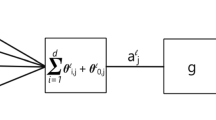Abstract
Combined with the nonmonotone line search, the two-point stepsize gradient method has successfully been applied for large-scale unconstrained optimization. However, the numerical performances of the algorithm heavily depend on M, one of the parameters in the nonmonotone line search, even for ill-conditioned problems. This paper proposes an adaptive nonmonotone line search. The two-point stepsize gradient method is shown to be globally convergent with this adaptive nonmonotone line search. Numerical results show that the adaptive nonmonotone line search is specially suitable for the two-point stepsize gradient method.
Similar content being viewed by others
References
H. Akaike, On a successive transformation of probability distribution and its application to the analysis of the optimum gradient method, Ann. Inst. Statist. Math. Tokyo 11 (1959) 1–17.
J. Barzilai and J.M. Borwein, Two point step size gradient methods, IMA J. Numer. Anal. 8 (1988) 141–148.
E.G. Birgin, I. Chambouleyron and J.M. Martínez, Estimation of the optical constants and the thickness of thin films using unconstrained optimization, J. Comput. Phys. 151 (1999) 862–880.
E.G. Birgin and Y.G. Evtushenko, Automatic differentiation and spectral projected gradient methods for optimal control problems, Optim. Methods Softw. 10 (1998) 125–146.
E.G. Birgin, J.M. Martínez and M. Raydan, Nonmonotone spectral projected gradient methods for convex sets, SIAM J. Optim. 10(4) (2000) 1196–1211.
A. Cauchy, Méthode générale pour la résolution des systèms d'equations simultanées, Comp. Rend. Sci. Paris 25 (1847) 46–89.
Y.H. Dai, On the nonmonotone line search, 2000 (accepted by JOTA).
Y.H. Dai and L.Z. Liao, R-linear convergence of the Barzilai and Borwein gradient method (1999), accepted by IMA J. Numer. Anal.
G.E. Forsythe, On the asymptotic directions of the s-dimensional optimum gradient method, Numer. Math. 11 (1968) 57–76.
A. Friedlander, J.M. Martínez, B. Molina and M. Raydan, Gradient method with retards and generalizations, SIAM J. Numer. Anal. 36 (1999) 275–289.
W. Glunt, T.L. Hayden and M. Raydan, Molecular conformations from distance matrices, J. Comput. Chem. 14 (1993) 114–120.
L. Grippo, F. Lampariello and S. Lucidi, A nonmonotone line search technique for Newton's method, SIAM J. Numer. Anal. 23 (1986) 707–716.
W.B. Liu and Y.H. Dai, Minimization algorithms based on supervisor and searcher co-operation: I – faster and robust gradient algorithms for minimization problems with stronger noises (1999), accepted by JOTA.
J.J. Morè, B.S. Garbow and K.E. Hillstrom, Testing unconstrained optimization software, ACMTrans. Math. Software 7 (1981) 17–41.
M. Raydan, On the Barzilai and Borwein choice of steplength for the gradient method, IMA J. Numer. Anal. 13 (1993) 321–326.
M. Raydan, The Barzilai and Borwein gradient method for the large scale unconstrained minimization problem, SIAM J. Optim. 7(1) (1997) 26–33.
Ph.L. Toint, A nonmonotone trust region algorithm for nonlinear optimization subject to convex constraints, Math. Prog. 77 (1997) 69–94.
Author information
Authors and Affiliations
Rights and permissions
About this article
Cite this article
Dai, YH., Zhang, H. Adaptive Two-Point Stepsize Gradient Algorithm. Numerical Algorithms 27, 377–385 (2001). https://doi.org/10.1023/A:1013844413130
Issue Date:
DOI: https://doi.org/10.1023/A:1013844413130




